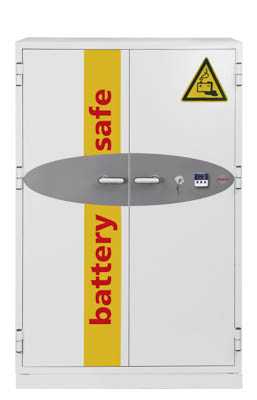Safe Approach to Charging Lithium-ion Batteries
December 3, 2023
Risk Mitigation and Best Practices

Charging Lithium-ion Batteries: Lithium-ion batteries power a vast array of devices in our modern world, from smartphones to electric vehicles. Their efficiency and capacity have revolutionized energy storage. However, with great power comes great responsibility. Charging these batteries improperly can lead to risks, including fires and explosions. Understanding these risks and employing strategies to mitigate them, such as secure storage and charging cabinets, is crucial for safety and longevity.
Understanding the Risks of Charging Lithium-ion Batteries
The Nature of Lithium-ion Batteries
Lithium-ion batteries store a large amount of energy in a compact space. This high energy density, while beneficial, can also pose risks. If a battery malfunctions or is improperly handled, it can overheat, leading to a process called thermal runaway. This chain reaction can cause the battery to catch fire or explode.
Common Causes of Malfunction
Several factors can lead to battery malfunctions:
- Overcharging: Applying too much voltage can cause excessive heat.
- Physical damage: Impacts or punctures can disrupt the internal structure.
- Electrical shorts: Internal or external shorts can lead to overheating.
- Poor quality: Low-quality or counterfeit batteries are more prone to failure.
Safe Charging Practices
Using the Right Charger
Always use the charger designed for your specific battery. Chargers that deliver inappropriate voltages can cause overcharging and overheating.
Monitoring the Charge
Never leave batteries charging unattended for extended periods. Regularly check for overheating, and always charge in a well-ventilated area.
Avoiding Extreme Temperatures
Charge batteries in a temperature-controlled environment. Extreme cold or heat can affect battery performance and safety.
The Role of Secure Storage and Charging Cabinets
Why Use Charging Cabinets for Charging Lithium-ion Batteries?
Charging cabinets specifically designed for lithium-ion batteries provide a controlled environment. These cabinets can prevent overheating and contain any incidents that may occur.
Features of a Good Charging Cabinet
When selecting a charging cabinet, look for:
- Fire-resistant materials: To contain any potential fires.
- Ventilation: To prevent overheating.
- Individual charging compartments: To isolate any malfunctioning batteries.
Implementing Charging Cabinets in Workplaces
Businesses that rely on lithium-ion batteries should invest in charging cabinets. This step ensures employee safety and protects the workplace from potential battery-related incidents.
Regular Battery Maintenance
Routine Checks
Regularly inspect batteries for signs of damage, like bulging or leaks. Replace damaged batteries immediately.
Updating Firmware
For smart batteries, ensure that the firmware is up to date. Manufacturers often release updates to improve safety.
Professional Disposal
Dispose of old or damaged batteries at a certified recycling center. Improper disposal can pose environmental and safety risks.
Conclusion
Charging lithium-ion batteries safely is a responsibility we should not take lightly. By understanding the risks, employing safe charging practices, and using tools like secure storage and charging cabinets, we can mitigate these risks. Regular maintenance and proper disposal further enhance safety. Let’s embrace the power of lithium-ion batteries, but always with a focus on safety and responsibility.
Discover more from Blog Total Locker Service
Subscribe to get the latest posts sent to your email.